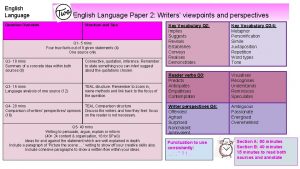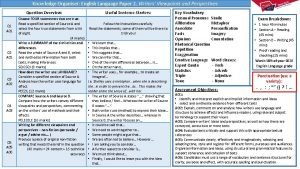Knowledge Organiser English Language Paper 2 Writers Viewpoints

- Slides: 1

Knowledge Organiser: English Language Paper 2, Writers’ Viewpoints and Perspectives Question Overview: Q 1 AO 1 Q 2 AO 1 Q 3 AO 2 Q 4 AO 3 Q 5 AO 6 Choose FOUR statements that are true. Read a specified section of Source A and select the four true statements from a list of eight. (4 marks) Write a SUMMARY of the similarities and differences. Read the whole of Source A and B, select and synthesise information from both texts, making inferences. SQICSQI (8 marks) How does the writer use LANGUAGE? Consider a specified section of Source A. Analyse how the writer uses language for effect. PEEZIL (12 marks) COMPARE Source A and Source B. Compare how the writers convey different viewpoints and perspectives, commenting on the writers’ use of methods and their effects. PELECELE (16 marks) Writing for different viewpoints and perspectives – non-fiction (persuade / argue / advise etc… ) Produce a piece of original non-fiction writing that meets the brief in the question (40 marks = 24 content + 16 technical accuracy) Useful Sentence Starters: Follow the instructions carefully. Read the statements, some of them will be there to trick you! We learn that… This implies that… This suggests that… We can infer that… One of the main differences between… is…. On the other hand… The writer uses… for example… to create an image of… i. e. Shelley uses a metaphor…when she is describing the…in order to present the…as… This makes the reader share the sense of…with her. • The writer of Source A states “…. ” showing that they believe / feel… Whereas the writer of Source B states “…. ”. • Both writers use (method) to express their ideas… • In Source A the writer describes… whereas in Source B, the writer focuses on… • It could be said that… • We need to work together to… • Some people might argue that… • We are often led to believe… However… • I am asking you to consider… • A further aspect to consider is… • We must think about… • Finally, I would like to leave you with the idea that. . . • • Key Vocabulary: Personal Pronouns Simile Alliteration Metaphor Anecdote Personification Facts Imagery Opinions Connotation Rhetorical Question Repetition Exaggeration Emotive Language Word classes: Expert Quote - Verb Statistics - Adverb Triple - Adjective Tone - Noun Assessment Objectives: Exam Breakdown: • 1 hour 45 minutes • Section A – Reading (45 mins) • Section B – Writing (45 mins) • Proof reading and checking (15 mins) Worth 50% of your GCSE English Language grade Punctuation (use a variety) : . , : ; “” () ? ! … AO 1: • identify and interpret explicit and implicit information and ideas • select and synthesise evidence from different texts AO 2: Explain, comment on and analyse how writers use language and structure to achieve effects and influence readers, using relevant subject terminology to support their views AO 3: Compare writers’ ideas and perspectives, as well as how these are conveyed, across two or more texts AO 4: Evaluate texts critically and support this with appropriate textual references AO 5: Communicate clearly, effectively and imaginatively, selecting and adapting tone, style and register for different forms, purposes and audiences. Organise information and ideas, using structural and grammatical features to support coherence and cohesion of texts AO 6: Candidates must use a range of vocabulary and sentence structures for clarity, purpose and effect, with accurate spelling and punctuation.

